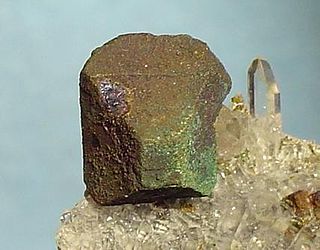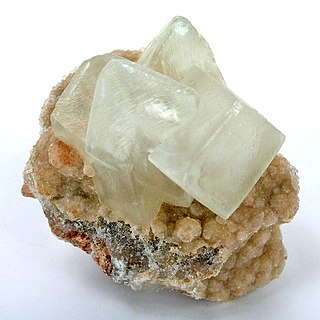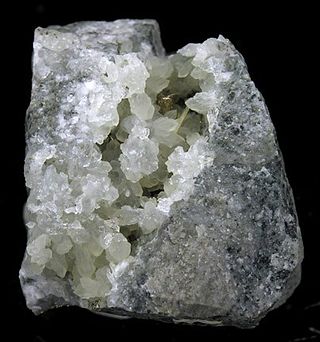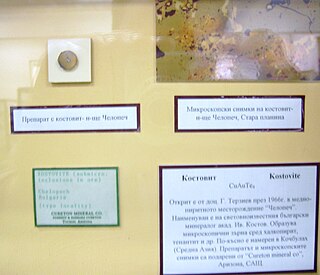
Bornite, also known as peacock ore, is a sulfide mineral with chemical composition Cu5FeS4 that crystallizes in the orthorhombic system (pseudo-cubic).

Smithsonite, also known as zinc spar, is the mineral form of zinc carbonate (ZnCO3). Historically, smithsonite was identified with hemimorphite before it was realized that they were two different minerals. The two minerals are very similar in appearance and the term calamine has been used for both, leading to some confusion. The distinct mineral smithsonite was named in 1832 by François Sulpice Beudant in honor of English chemist and mineralogist James Smithson (c. 1765–1829), who first identified the mineral in 1802.

Calaverite, or gold telluride, is an uncommon telluride of gold, a metallic mineral with the chemical formula AuTe2, with approximately 3% of the gold replaced by silver. It was first discovered in Calaveras County, California in 1861, and was named for the county in 1868.

Sylvanite or silver gold telluride, chemical formula (Ag,Au)Te2, is the most common telluride of gold.

Bismuthinite is a mineral consisting of bismuth sulfide (Bi2S3). It is an important ore for bismuth. The crystals are steel-grey to off-white with a metallic luster. It is soft enough to be scratched with a fingernail and rather dense.

Altaite, or lead telluride, is a yellowish white mineral with an isometric crystal structure. Altaite is in the galena group of minerals as it shares many of properties of galena. Altaite has an unusually high density for a light-colored mineral. Altaite and other rare tellurides are classified in the sulfide mineral class.

Krennerite is an orthorhombic gold telluride mineral which can contain variable amounts of silver in the structure. The formula is AuTe2, but specimen with gold substituted by up to 24% with silver have been found ([Au0.77Ag0.24]Te2). Both of the chemically similar gold-silver tellurides, calaverite and sylvanite, are in the monoclinic crystal system, whereas krennerite is orthorhombic.

Rickardite is a telluride mineral, a copper telluride (Cu7Te5) or Cu3-x (x = 0 to 0.36)Te2. It was first described for an occurrence in the Good Hope Mine, Vulcan district, Gunnison County, Colorado, US, and named for mining engineer Thomas Arthur Rickard (1864–1953). It is a low temperature hydrothermal mineral that occurs associated with vulcanite, native tellurium, cameronite, petzite, sylvanite, berthierite, pyrite, arsenopyrite and bornite.
Weissite is a telluride mineral, a copper telluride. Its chemical formula is Cu
2−xTe. Weissite has hexagonal crystal structure. Its specific gravity is 6 and its Mohs hardness is 3. Occurrence is in Gunnison County, Colorado, Arizona and New Mexico in the United States. It is also reported from Kalgoorlie, Western Australia and Dalarna and Värmland, Sweden.

Stolzite is a mineral, a lead tungstate; with the formula PbWO4. It is similar to, and often associated with, wulfenite which is the same chemical formula except that the tungsten is replaced by molybdenum. Stolzite crystallizes in the tetragonal crystal system and is dimorphous with the monoclinic form raspite.

Tellurobismuthite, or tellurbismuth, is a telluride mineral: bismuth telluride (Bi2Te3). It crystallizes in the trigonal system. There are natural cleavage planes in the (0001) direction as the crystal is effectively lamellar (layered) in that plane. The Mohs hardness is 1.5 – 2 and the specific gravity is 7.815. It is a dull grey color, which exhibits a splendent luster on fresh cleavage planes.

Nagyágite is a rare sulfide mineral with known occurrence associated with gold ores. Nagyágite crystals are opaque, monoclinic and dark grey to black coloured.

Coloradoite, also known as mercury telluride (HgTe), is a rare telluride ore associated with metallic deposit. Gold usually occurs within tellurides, such as coloradoite, as a high-finess native metal.

Stützite or stuetzite is a silver telluride mineral with formula: Ag5−xTe3 (with x = 0.24 to 0.36) or Ag7Te4.

Kostovite (IMA symbol: Ktv) is a rare orthorhombic-pyramidal gray white telluride mineral containing copper and gold with chemical formula AuCuTe4.
Bilibinskite is an Au – Cu – Pb telluride. It is a rare mineral that was named after Soviet geologist Yuri Bilibin (1901–1952), who researched the geology of gold deposits during the time of the USSR.
Telluro-silver glance — is a trivial name given by collectors and mineral dealers, miners, geologists and other professions to at least two ore mineralsrare ore minerals, tellurides of silver. It may refer to:
Telluric silver — is an obsolete trivial name, which collectors and mineral traders, miners, geologists and representatives of other applied professions actually applied to several rare ore minerals, tellurides of silver, as well as to chemical compounds of similar composition. It may refer to:

Frohbergite (German: Frohbergit, title by proper name: Max Hans Frohberg), also iron telluride is a rare hydrothermal mineral from the sulfide class, in composition — iron telluride with the ideal formula FeTe2 (contains 82.05% tellurium and 17.95% iron).

Montbrayite (from a Canadian toponym) is a very rare mineral from among the gold tellurides, close to krennerite and calaverite, in composition it is a mixed polymetallic plumbotelluride of gold with a variable formula, initially written as Au2Te3, or (Au,Sb)2Te3, but today having a much more complex form in the calculated form: (Au,Ag,Sb,Bi,Pb)23(Te,Sb,Bi,Pb)38. The color of montbrayite is cream, tin-white to pale yellow, the luster is metallic.
















